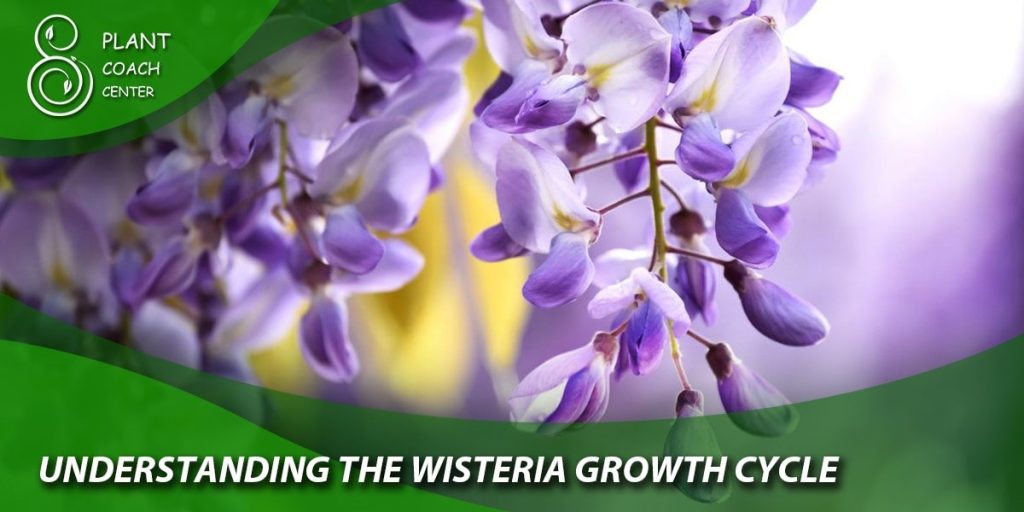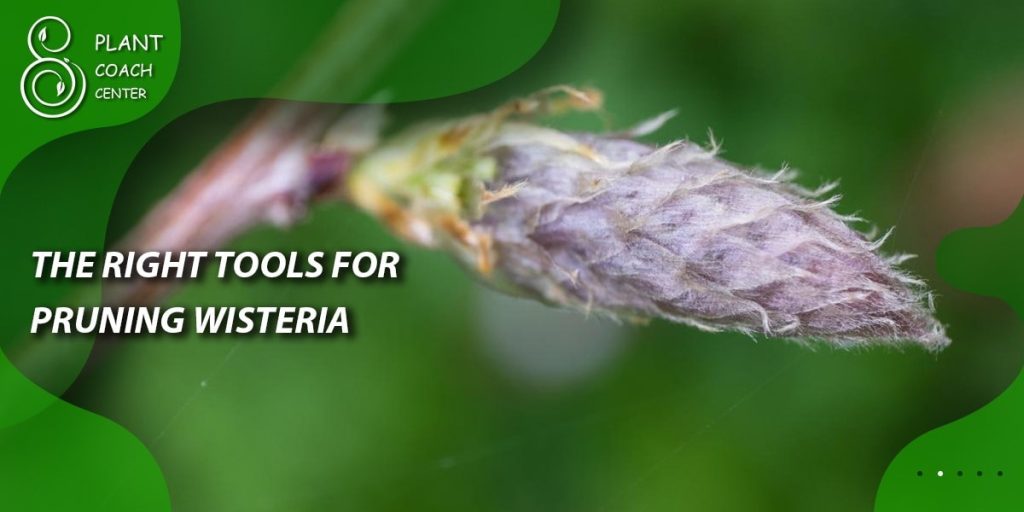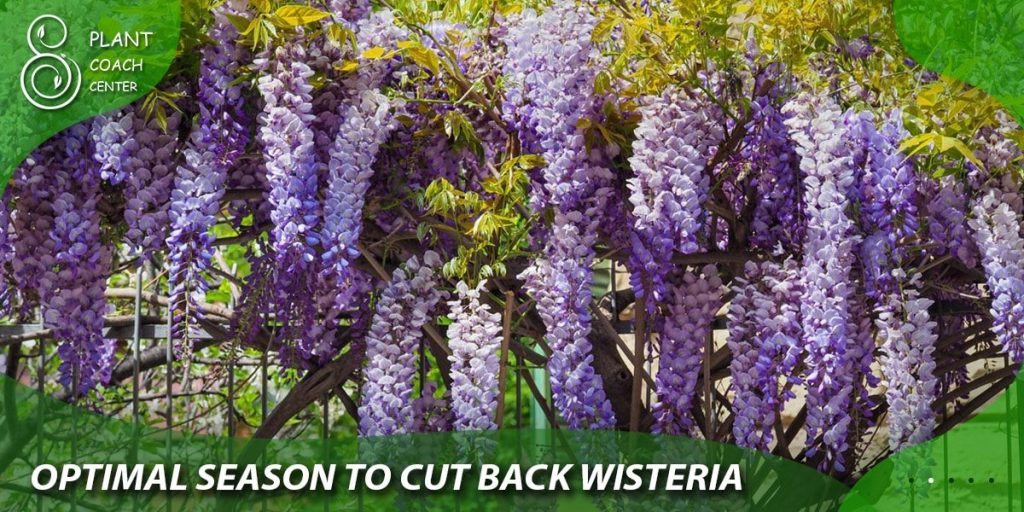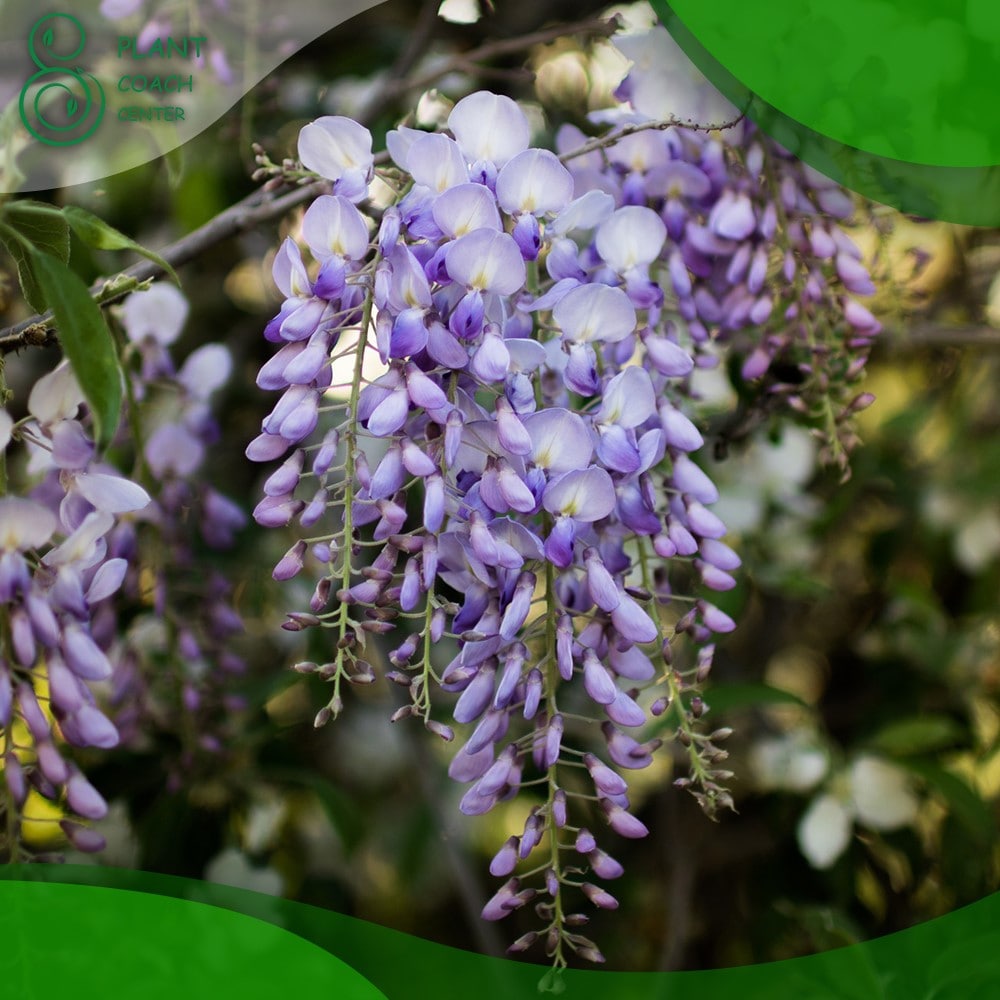When to Cut Back Wisteria
Gardening enthusiasts often find themselves captivated by the enchanting beauty of wisteria. This climbing vine, known for its cascading blooms and lush foliage, adds a touch of elegance to any garden or landscape. However, cultivating a thriving wisteria requires more than just admiration; it demands a level of understanding and care that can be achieved through plant coaching.

The Wisteria Plant: A Closer Look
Wisteria, part of the Fabaceae family, boasts several species and varieties, each with unique charms. From the exquisite Japanese Wisteria (Wisteria floribunda) to the graceful Chinese Wisteria (Wisteria sinensis) and the hardy American Wisteria (Wisteria frutescens), gardeners have a variety of options to choose from. Understanding these species’ growth habits and characteristics is key to providing them with the care they deserve.
The Importance of Pruning in Wisteria Care
Pruning is a fundamental aspect of wisteria care that holds significant importance in promoting the overall health and vitality of the plant. As a climbing vine, wisteria has a natural inclination to grow vigorously, sometimes overwhelming its surroundings. Without proper pruning, the plant’s exuberant growth can lead to a tangled mess of branches, limited blooming, and potential damage to nearby structures or other plants.
The primary objectives of pruning wisteria are multifaceted:
Encouraging flowering
One of the main reasons gardeners cultivate wisteria is for its breathtaking blooms. However, wisteria can be a bit fussy when it comes to flowering. If left unpruned or inadequately pruned, the plant may channel most of its energy into vegetative growth, producing abundant foliage but few or no blooms. Pruning helps balance vegetative growth and flowering, ensuring the plant devotes enough energy to produce those much-anticipated clusters of cascading flowers.
Controlling Growth and Vigor
Wisteria is notorious for its vigorous growth; in some cases, it can become unruly and invasive. The plant may spread uncontrollably without pruning, potentially overtaking nearby structures, trees, or other plants. Pruning is a proactive measure to keep the plant in check, maintaining its size and shape to suit the garden’s aesthetics while preventing it from becoming a nuisance.
Enhancing Air Circulation
Wisteria’s dense foliage can impede proper airflow, creating a humid environment that may foster the growth of pests and diseases. Gardeners can encourage better air circulation through the plant by selectively pruning branches and thinning out some of the dense growth. Improved airflow reduces the risk of pests and diseases and promotes a healthier, more robust wisteria.
Removing Weak or Diseased Growth
Regular pruning allows gardeners to inspect the plant thoroughly, identifying and removing weak, dead, or diseased branches. Eliminating such growth not only improves the plant’s overall appearance but also prevents the spread of diseases and enhances its ability to redirect nutrients to healthier parts of the vine.
Shaping and training
Pruning is an essential technique for shaping and training wisteria to suit the desired garden structure or design. Whether growing the vine as a tree, covering a pergola, or cascading over a trellis, pruning plays a crucial role in achieving and maintaining the desired form over time.
Timing of Pruning
Timing is crucial when it comes to pruning wisteria. Different pruning techniques are employed at various plant growth cycle points to achieve specific goals. During the dormant season, winter pruning allows for more substantial cuts and shaping. Spring pruning involves tidying up after the blooming season and removing spent blooms. Summer pruning focuses on managing rampant growth and keeping the plant in check. Each pruning session contributes to the long-term health and aesthetics of the wisteria.
Pruning is not merely an optional chore in wisteria care; it is an essential practice that significantly impacts the plant’s health, flowering potential, and overall appearance. By embracing and incorporating the art of pruning into a comprehensive plant coaching strategy, gardeners can enjoy a thriving and visually striking wisteria that adds a touch of natural splendor to their outdoor spaces.

Understanding the Wisteria Growth Cycle
To master the art of pruning, one must first comprehend the natural growth cycle of wisteria. In spring, wisteria adorns itself with breathtaking blooms, signaling the start of the growing season. As summer approaches, the plant enters a vigorous growth phase, requiring close attention. Fall brings seed pod development; by winter, wisteria enters a dormant state, preparing for the next blooming season.
Signs It’s Time to Cut Back Wisteria
Knowing when to cut back on wisteria is essential for maintaining its health and appearance. Pruning at the appropriate moments allows you to manage the plant’s growth and ensure its long-term well-being. Here are some key signs that indicate it’s time to cut back on wisteria:
Overgrowth and Excessive Vigor:
When wisteria experiences abundant growth, it can quickly become overwhelming and out of control. Suppose you notice the vine spreading rapidly, overtaking nearby structures, or growing into areas it shouldn’t. In that case, it’s a clear sign that it’s time to cut back. Pruning in such instances helps prevent the plant from becoming unmanageable and keeps it in harmony with its surroundings.
Limited or No Blooming:
Wisteria’s spectacular flowering is one of its most prized features. However, if your wisteria produces little to no blooms, it could indicate that pruning is required. When wisteria focuses too much on vegetative growth without receiving adequate pruning, it may not allocate enough resources to flower production. By cutting back the plant, you encourage it to direct energy toward blooming and enhance the chances of a breathtaking floral display.
Unhealthy or Diseased Branches:
Regularly inspect your wisteria for any signs of weakness, disease, or damage. Dead or diseased branches can hinder the plant’s health and potentially spread problems to other vine parts. If you identify any compromised branches, removing them promptly is crucial by cutting back to healthy wood. Pruning out these problem areas helps promote the flow of nutrients to healthy parts of the plant, contributing to its recovery and vitality.
Overcrowding Issues:
As wisteria grows, it can become quite dense, overcrowding its branches. Overcrowded areas are prone to reduced sunlight penetration and poor air circulation, creating a favorable environment for pests and diseases. Additionally, overcrowding may result in some branches competing for resources, leading to stunted growth. Cutting back specific branches or thinning out dense growth enhances the plant’s overall health and encourages balanced development.
Shaping and maintenance:
Cutting back wisteria is crucial for shaping and maintaining its structure. Whether you desire a specific form, such as a tree-like shape or a graceful cascading appearance, regular pruning is necessary to achieve and retain the desired design. Without pruning, wisteria can lose its shape, potentially interfering with the aesthetics of your garden or landscape.
After Blooming Season:
In many cases, wisteria pruning occurs after the blooming season. After the flowers have faded, it’s an ideal time to perform light pruning, removing spent blooms and excessive growth during the flowering period. This practice helps maintain a neat appearance and prepares the plant for the growing season.
Observing these signs and being proactive in your wisteria care ensures the plant remains healthy, beautiful, and well-balanced throughout its growth. Remember to combine your pruning efforts with an understanding of the plant’s growth cycle and specific variety to achieve optimal results and enjoy the full splendor of your wisteria.
The Right Tools for Pruning Wisteria
Equipping yourself with the right tools can make all the difference in successful wisteria pruning. A sturdy pair of pruning shears, loppers, and a pruning saw is essential for cutting through thicker branches. Prioritizing safety is equally important, so wearing protective gear such as gloves and safety goggles is necessary.

Step-by-Step Guide to Pruning Wisteria
Pruning wisteria is a step-by-step process that carefully considers the plant’s growth cycle and specific goals. Whether you are shaping the wisteria, encouraging more blooms, or controlling its size, following these steps will help you achieve successful pruning results:
Step 1: Timing Matters
Timing is crucial when it comes to wisteria pruning. The ideal time for major pruning is during the dormant season, typically in winter when the plant is not actively growing. Major cuts during this period help shape the plant and control its size without affecting the flowering potential. However, light pruning, such as removing spent blooms and tidying up the vine, can also be done after the blooming season in late spring.
Step 2: Assess the Wisteria
Before you begin pruning:
- Take a close look at the wisteria.
- Identify any weak, damaged, or diseased branches that need removal.
- Evaluate the overall shape and structure of the plant, and visualize the desired outcome. This assessment will guide you in making informed decisions during the pruning process.
Step 3: Prepare the Pruning Tools
Ensure you have the right pruning tools for the job. A sharp pair of pruning shears, loppers, and a pruning saw are essential for cutting through various branch sizes. Clean and sanitize your tools before use to prevent the spread of diseases between cuts.
Step 4: Pruning During Dormant Season (Winter)
During the dormant season, you can perform more substantial cuts to shape and control the wisteria. Identify the main branches that form the framework of the plant and prune them back to about three to five buds from the main stem. This encourages lateral branching, which leads to a more robust flowering display.
Step 5: Pruning During Blooming Season (Spring)
After the wisteria has finished blooming, it’s time to perform light pruning to maintain its appearance and prepare it for the next growing season. Remove any spent blooms by returning them to a healthy bud or lateral branch. This process is known as “deadheading” and encourages the plant to put more energy into developing new blooms.
Step 6: Summer Pruning
Wisteria may exhibit vigorous growth in summer, sending out long shoots and tendrils in all directions. Summer pruning focuses on managing this rampant growth to prevent it from taking over the garden. Cut back any overly long shoots to maintain the desired shape and size of the plant. Additionally, thin out crowded areas to improve air circulation and reduce disease risk.
Step 7: Fall Pruning
Fall is a good time to tidy up the wisteria before it enters its dormant period again. Remove any dead or diseased branches and perform light shaping to ensure the plant’s structure remains intact throughout the winter.
Step 8: Train the Wisteria
Train the wisteria to grow along the desired support structure, such as a pergola, trellis, or wall, throughout the pruning process. Gently guide the new growth to follow the intended path and secure it in place with ties or soft twine. Proper training ensures the wisteria grows in a way that enhances the garden’s aesthetics and prevents it from growing in undesirable directions.
Step 9: Regular Maintenance
Remember that wisteria pruning is not a one-time event; it requires regular maintenance to keep the plant healthy and visually appealing. Regularly inspect the plant for any issues, and address them promptly with appropriate pruning techniques.

Special Considerations for Different Wisteria Varieties
Each wisteria variety has unique characteristics and growth patterns. Understanding these distinctions is crucial for effective pruning. Japanese wisteria may require more aggressive pruning due to its vigorous growth. In contrast, Chinese wisteria might benefit from a lighter touch.
Common Mistakes to Avoid When Cutting Back Wisteria
Pruning mistakes can lead to setbacks and challenges in wisteria care. Over-pruning can weaken the plant, while improper timing might hamper blooming. Consistency and patience are key to achieving the desired results.
Wisteria Pests and Diseases: How Pruning Can Help
Like any other plant, wisteria is susceptible to pests and diseases that can compromise its health. Regular pruning can aid in preventing and managing these issues by allowing better airflow and reducing potential hiding spots for pests. Familiarizing oneself with common wisteria pests and diseases is essential for early detection and effective intervention.
Pruning Wisteria in Different Garden Settings
Wisteria’s versatility allows it to thrive in various garden setups. Growing wisteria in containers is a practical option for those with limited space. Trained on pergolas and trellises, wisteria can create stunning outdoor spaces with natural shade and privacy. Alternatively, employing espalier techniques can transform wisteria into an artistic and space-saving garden feature.
Reviving an Overgrown or Unhealthy Wisteria
While wisteria is known for its tenacity, sometimes plants can become overgrown or unhealthy due to neglect or adverse conditions. Reviving such wisteria requires a systematic approach, including drastic rejuvenation or root pruning in extreme cases. With patience and proper care, wisteria can return to its former glory.
Conclusion
Wisteria is a delightful addition to any garden with its breathtaking blooms and enchanting allure. Mastering the art of pruning through plant coaching is crucial to maintain a healthy and beautiful wisteria. By understanding the plant’s growth cycle, recognizing the signs that indicate pruning is needed, and employing proper techniques and tools, gardeners can ensure their wisteria flourishes year after year.
As with any aspect of gardening, patience and observation are key. Every wisteria plant is unique, and tailoring pruning practices to suit its specific needs can result in a thriving and picturesque vine. With diligent care, wisteria can reward gardeners with a splendid display of flowers and an enduring connection to the natural world.
Gardening is a journey of discovery and learning, and embracing the nuances of wisteria care can be both rewarding and fulfilling. As you embark on this green adventure, remember that nature has its way of guiding you. With a little nurturing, your wisteria will bloom into a masterpiece of botanical beauty.
When is the best time to prune Wisteria?
Prune wisteria during the dormant season in winter or after blooming in late spring.
How can I encourage more wisteria blooms?
Regularly prune deadhead spent blooms, and ensure adequate sunlight for optimal flowering.
What tools do I need for wisteria pruning?
Pruning shears, loppers, and a pruning saw are essential for effective wisteria pruning.







